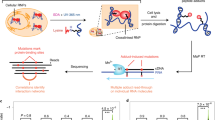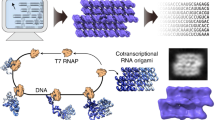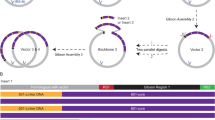Abstract
We present RNA–mechanically induced trapping of molecular interactions (RNA-MITOMI), a microfluidic platform that allows integrated synthesis and functional assays for programmable RNA libraries. The interaction of a comprehensive library of RNA mutants with stem-loop–binding protein precisely defined the RNA structural and sequence features that govern affinity. The functional motif reconstructed in a single experiment on our platform uncovers new binding specificities and enriches interpretation of phylogenetic data.
This is a preview of subscription content, access via your institution
Access options
Subscribe to this journal
Receive 12 print issues and online access
$259.00 per year
only $21.58 per issue
Buy this article
- Purchase on Springer Link
- Instant access to full article PDF
Prices may be subject to local taxes which are calculated during checkout



Similar content being viewed by others
References
Djebali, S. et al. Nature 489, 101–108 (2012).
Martin, L. & Chang, H.Y. J. Clin. Invest. 122, 1589–1595 (2012).
Guttman, M. & Rinn, J.L. Nature 482, 339–346 (2012).
Cooper, G.M. & Shendure, J. Nat. Rev. Genet. 12, 628–640 (2011).
Marzluff, W.F., Wagner, E.J. & Duronio, R.J. Nat. Rev. Genet. 9, 843–854 (2008).
Maerkl, S.J. & Quake, S.R. Science 315, 233–237 (2007).
Battle, D.J. & Doudna, J.A. RNA 7, 123–132 (2001).
Davila Lopez, M. & Samuelsson, T. RNA 14, 1–10 (2008).
Williams, A.S. & Marzluff, W.F. Nucleic Acids Res. 23, 654–662 (1995).
Dominski, Z., Yang, X.C., Kaygun, H., Dadlez, M. & Marzluff, W.F. Mol. Cell 12, 295–305 (2003).
Yang, X.C., Purdy, M., Marzluff, W.F. & Dominski, Z. J. Biol. Chem. 281, 30447–30454 (2006).
Koenig, J., Zarnack, K., Luscombe, N.M. & Ule, J. Nat. Rev. Genet. 13, 77–83 (2011).
Zhao, J. et al. Mol. Cell 40, 939–953 (2010).
Granneman, S., Kudla, G., Petfalski, E. & Tollervey, D. Proc. Natl. Acad. Sci. USA 106, 9613–9618 (2009).
Chu, C., Qu, K., Zhong, F.L., Artandi, S.E. & Chang, H.Y. Mol. Cell 44, 667–678 (2011).
Liang, J.C., Bloom, R.J. & Smolke, C.D. Mol. Cell 43, 915–926 (2011).
Acknowledgements
We thank R.C. Spitale and C. Chu for helpful discussions, J.C. Liang, R.J. Bloom and C.D. Smolke for helpful discussions and assistance with Biacore, and A. Clore of Integrated DNA Technologies for assistance with probe designs. L.M. was funded by the Department of Defense National Defense Science & Engineering Graduate Fellowship. Our work was supported by US National Institutes of Health R01-HG004361 (to H.Y.C.) and R01GM29832 (to W.F.M.). H.Y.C. and S.R.Q. are funded by the Howard Hughes Medical Institute.
Author information
Authors and Affiliations
Contributions
L.M., S.R.Q. and H.Y.C. conceived the study. L.M., M.M., S.M.L. and R.V.S. performed experiments. L.M., M.M., S.M.L., W.F.M., S.R.Q. and H.Y.C. discussed the results and analyzed the data. L.M. and H.Y.C. wrote the paper.
Corresponding authors
Ethics declarations
Competing interests
The authors declare no competing financial interests.
Supplementary information
Supplementary Text and Figures
Supplementary Figures 1–10, Supplementary Tables 1–4, Supplementary Notes 1–2 (PDF 5979 kb)
Rights and permissions
About this article
Cite this article
Martin, L., Meier, M., Lyons, S. et al. Systematic reconstruction of RNA functional motifs with high-throughput microfluidics. Nat Methods 9, 1192–1194 (2012). https://doi.org/10.1038/nmeth.2225
Received:
Accepted:
Published:
Issue Date:
DOI: https://doi.org/10.1038/nmeth.2225
This article is cited by
-
Systematic analysis of low-affinity transcription factor binding site clusters in vitro and in vivo establishes their functional relevance
Nature Communications (2022)
-
A three-dimensional microfluidic mixer of a homogeneous mixing efficiency fabricated by ultrafast laser internal processing of glass
Applied Physics A (2020)
-
Molecular fossils “pseudogenes” as functional signature in biological system
Genes & Genomics (2020)
-
Technologies to probe functions and mechanisms of long noncoding RNAs
Nature Structural & Molecular Biology (2015)
-
Microfluidics: reframing biological enquiry
Nature Reviews Molecular Cell Biology (2015)



